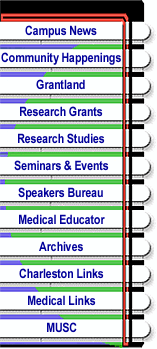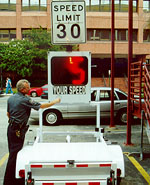
Return to Main Menu |
Speed
monitor to promote safety awareness at MUSC
by Chris West
Public Relations
Lead-footed motorists, beware! Public Safety’s newest “employee”
is watching, monitoring and most of all, showing you how fast you’re going.
“The most motivating factor in acquiring the Speed Monitor Trailer
is to increase citizen awareness of their speed,” said Lt. Terry Howell,
Public Safety. “Many areas of campus have high pedestrian and vehicular
traffic and motorists need to be aware of their rate of speed to ensure
the safety of all.”
 Lt.
Terry Howell, Public Safety, sets up the speed monitor. Lt.
Terry Howell, Public Safety, sets up the speed monitor.
The Speed Monitor Trailer is a speed curbing device designed to display
the posted speed limit and then using radar technology, it monitors and
displays a vehicle's rate of speed.
The trailer has several features that heighten its ability to alert
drivers of their speed. The posted speed limit is set high upon the top
of the display box, the display numerals are 18 inches high and will flash
if a passing driver's speed is above the posted limit. The unit also has
a large window area so passing drivers can see if anything is directly
behind the trailer.
The first major vein of traffic to see the trailer in use will be Ashley
Avenue on the block between Sabin and Bee streets. It should be positioned
within the next week.
“The decision to purchase the trailer was a proactive decision on the
part of Charles Wiley, chief of Public Safety. His budget proposal was
submitted and the trailer was one item under consideration,” Howell said.
It was readily approved by administration.
The trailer was a welcome public safety addition based on its performance
in past studies. In one study conducted in San Diego, with a speed monitor
placed in school zones, speeds were reduced on an average of five to eight
miles per hour and speeding occurrences were reduced from 77 percent of
drivers exceeding the posted limit to 20 percent. The effects were long-lasting
as well, in that the percent remained close to 20 well after the trailer
had been removed.
Studies were conducted at Texas A&M and at the University of Nebraska.
Both institutions reflected similar situations and results.
Howell expects that the trailer will be received with the same positive
effects by staff, students and especially the surrounding community as
it was with MUSC administration supporting the Department of Public Safety
and its concern with the campus and its neighbors.
Howell said the entire force will be trained in the use and operation
of the trailer and it will be premiered at the Law Enforcement Day celebration,
Sept. 16 at Northwoods Mall.
The trailer is built very ruggedly, it has high-security locks on the
storage box and the aperture that raises the display box and an axle lock
that prevents the unit from being moved or rolled. The structure itself
is also coated in graffiti-resistant paint.
“People are just more in a hurry than in the past. Speeding is a conscious
decision on the part of the driver and people are just more inclined to
get to where they are going in much more of a rush than they used to be.
It has gotten very aggressive out there,” Howell said.
“Attaining and implementing the trailer was a self-initiative to maintain
order and promote roadway safety decreasing driving situations. As a campus,
we are a small part of a greater community. We are simply trying to be
good neighbors.”
Information regarding the trailer and pictures of the trailer are available
on the Public Safety Web site at <http://www.musc.edu/publicsafety>.
|



 Lt.
Terry Howell, Public Safety, sets up the speed monitor.
Lt.
Terry Howell, Public Safety, sets up the speed monitor.